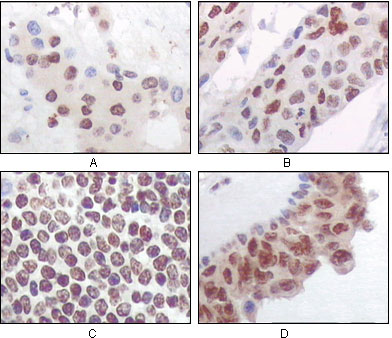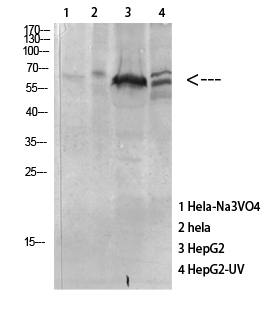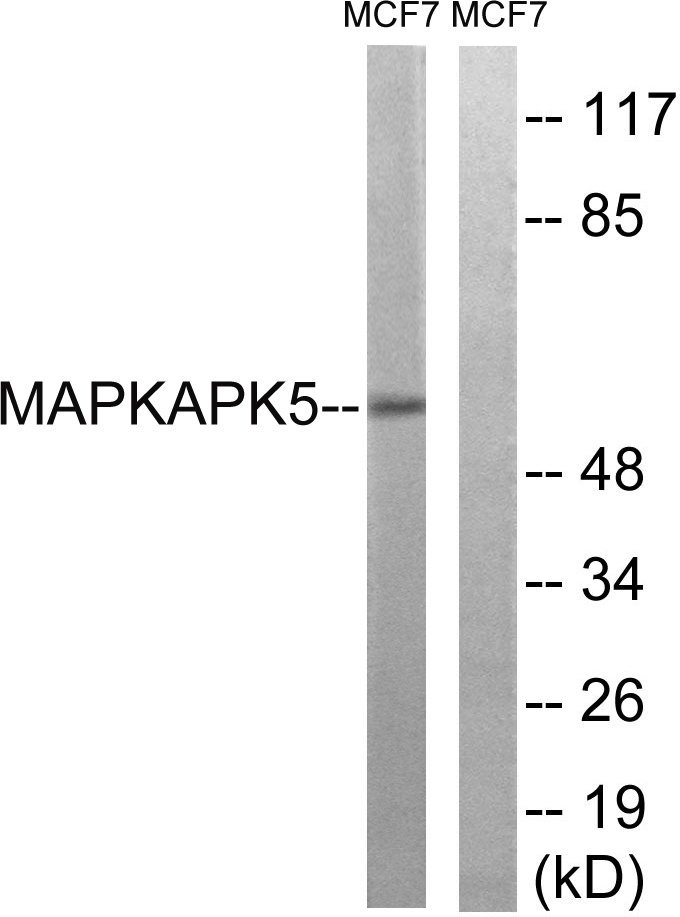PRAK Monoclonal Antibody
- Catalog No.:YM0533
- Applications:WB;IHC;IF;ELISA
- Reactivity:Human
- Target:
- MAPKAPK5
- Fields:
- >>MAPK signaling pathway
- Gene Name:
- MAPKAPK5
- Protein Name:
- MAP kinase-activated protein kinase 5
- Human Gene Id:
- 8550
- Human Swiss Prot No:
- Q8IW41
- Mouse Swiss Prot No:
- O54992
- Immunogen:
- Purified recombinant fragment of PRAK expressed in E. Coli.
- Specificity:
- PRAK Monoclonal Antibody detects endogenous levels of PRAK protein.
- Formulation:
- Liquid in PBS containing 50% glycerol, 0.5% BSA and 0.02% sodium azide.
- Source:
- Monoclonal, Mouse
- Dilution:
- WB 1:500 - 1:2000. IHC 1:200 - 1:1000. ELISA: 1:10000.. IF 1:50-200
- Purification:
- Affinity purification
- Storage Stability:
- -15°C to -25°C/1 year(Do not lower than -25°C)
- Other Name:
- MAPKAPK5;PRAK;MAP kinase-activated protein kinase 5;MAPK-activated protein kinase 5;MAPKAP kinase 5;MAPKAP-K5;MAPKAPK-5;MK-5;MK5;p38-regulated/activated protein kinase;PRAK
- Molecular Weight(Da):
- 54kD
- References:
- 1. Paliga AJ. Natale DR. Watson AJ. Biol Cell. 2005, Aug, 97(8):629-40.
2. Wijtten PJ. Prak R. Lemme A. et al. Br Poult Sci. 2004, Aug, 45(4):504-11.
3. New L. Jiang Y. Han J. Mol Biol Cell. 2
- Background:
- The protein encoded by this gene is a tumor suppressor and member of the serine/threonine kinase family. In response to cellular stress and proinflammatory cytokines, this kinase is activated through its phosphorylation by MAP kinases including MAPK1/ERK, MAPK14/p38-alpha, and MAPK11/p38-beta. The encoded protein is found in the nucleus but translocates to the cytoplasm upon phosphorylation and activation. This kinase phosphorylates heat shock protein HSP27 at its physiologically relevant sites. Two alternately spliced transcript variants of this gene encoding distinct isoforms have been reported. [provided by RefSeq, Nov 2012],
- Function:
- catalytic activity:ATP + a protein = ADP + a phosphoprotein.,enzyme regulation:p38 alpha and beta-dependent phosphorylation increases its activity. Activated by stress-related extracellular stimuli; such as H(2)O(2), arsenite, anisomycin TNF alpha and also PMA and the calcium ionophore A23187; but to a lesser extent. In vitro, activated by SQSTM1.,function:Mediates stress-induced small heat shock protein 27 phosphorylation.,PTM:Phosphorylated on Thr-182; which is the regulatory phosphorylation site and is located on the T-loop/loop 12.,similarity:Belongs to the protein kinase superfamily. CAMK Ser/Thr protein kinase family.,similarity:Contains 1 protein kinase domain.,subcellular location:Also observed in the nucleus.,subunit:Interacts with SQSTM1.,tissue specificity:Expressed ubiquitously.,
- Subcellular Location:
- Cytoplasm. Nucleus. Translocates to the cytoplasm following phosphorylation and activation. Interaction with ERK3/MAPK6 or ERK4/MAPK4 and phosphorylation at Thr-182, activates the protein kinase activity, followed by translocation to the cytoplasm. Phosphorylation by PKA/PRKACA at Ser-115 also induces nuclear export.
- Expression:
- Expressed ubiquitously.
- June 19-2018
- WESTERN IMMUNOBLOTTING PROTOCOL
- June 19-2018
- IMMUNOHISTOCHEMISTRY-PARAFFIN PROTOCOL
- June 19-2018
- IMMUNOFLUORESCENCE PROTOCOL
- September 08-2020
- FLOW-CYTOMEYRT-PROTOCOL
- May 20-2022
- Cell-Based ELISA│解您多样本WB检测之困扰
- July 13-2018
- CELL-BASED-ELISA-PROTOCOL-FOR-ACETYL-PROTEIN
- July 13-2018
- CELL-BASED-ELISA-PROTOCOL-FOR-PHOSPHO-PROTEIN
- July 13-2018
- Antibody-FAQs
- Products Images

- Western Blot analysis using PRAK Monoclonal Antibody against truncated PRAK recombinant protein.

- Immunohistochemistry analysis of paraffin-embedded human liver carcinoma (A), esophagus carcinoma (B), normal spleen tissue(C), breast carcinoma (D), showing nuclear and cytoplasmic localization with DAB staining using PRAK Monoclonal Antibody.


